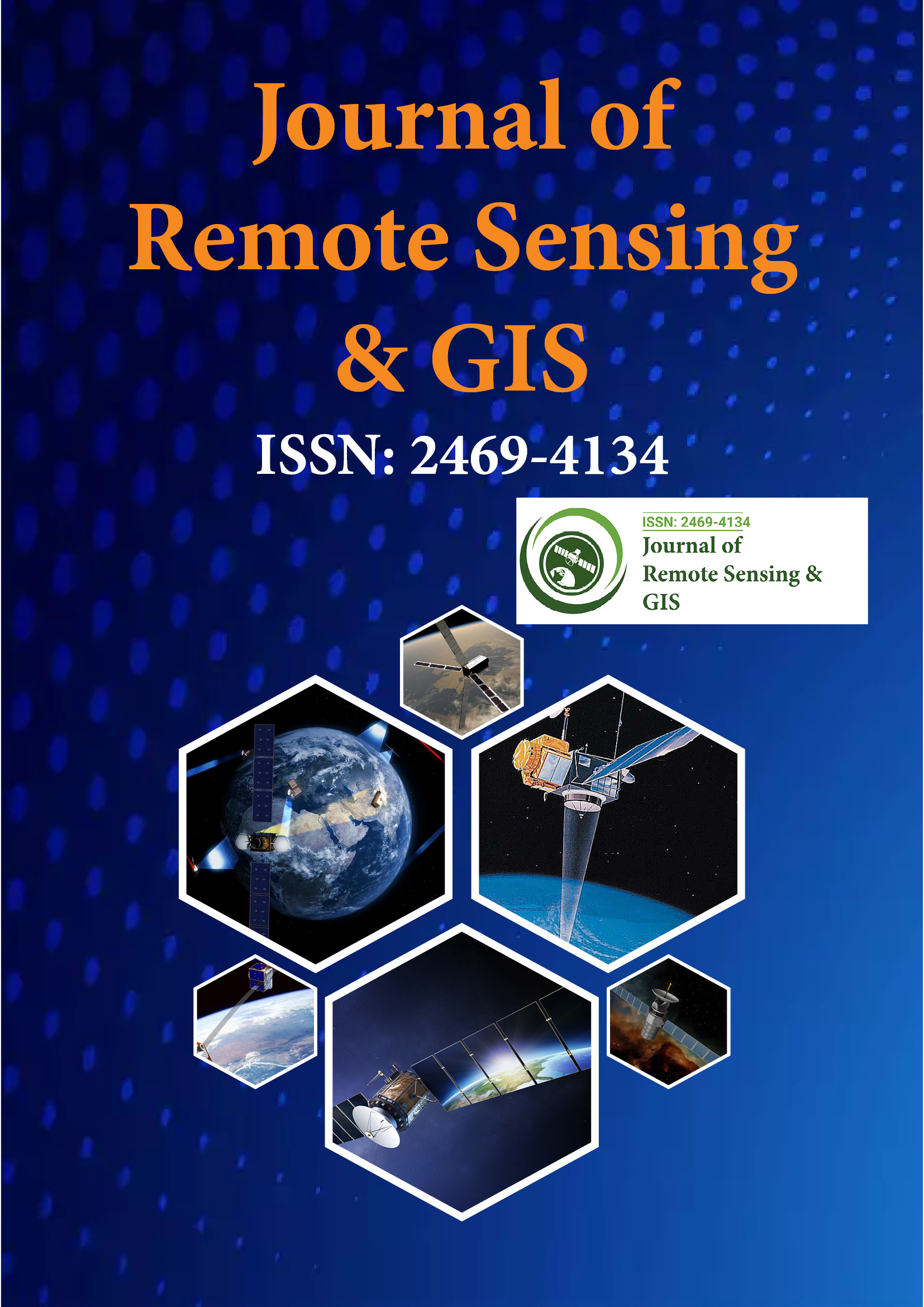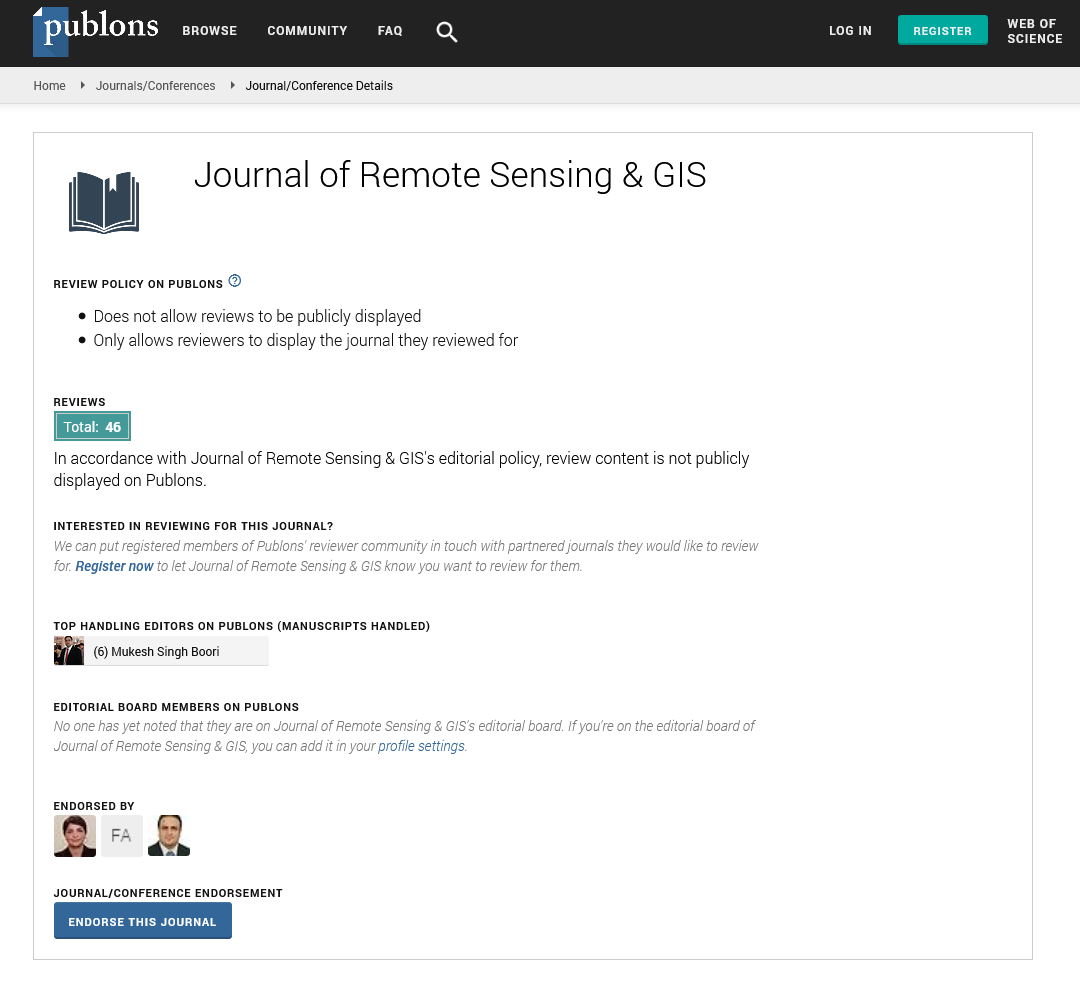Indexed In
- Open J Gate
- RefSeek
- Hamdard University
- EBSCO A-Z
- OCLC- WorldCat
- Publons
- International Scientific Indexing
- Euro Pub
- Google Scholar
Useful Links
Share This Page
Journal Flyer

Open Access Journals
- Agri and Aquaculture
- Biochemistry
- Bioinformatics & Systems Biology
- Business & Management
- Chemistry
- Clinical Sciences
- Engineering
- Food & Nutrition
- General Science
- Genetics & Molecular Biology
- Immunology & Microbiology
- Medical Sciences
- Neuroscience & Psychology
- Nursing & Health Care
- Pharmaceutical Sciences
Perspective - (2025) Volume 14, Issue 1
Remote Sensing for the Ocean Environment: Techniques, Applications and Insights into Marine Ecosystem Health
Jacob Paul*Received: 25-Feb-2025, Manuscript No. JGRS-25-28688; Editor assigned: 27-Feb-2025, Pre QC No. JGRS-25-28688 (PQ); Reviewed: 14-Mar-2025, QC No. JGRS-25-28688; Revised: 21-Mar-2025, Manuscript No. JGRS-25-28688 (R); Published: 28-Mar-2025, DOI: 10.35248/2469-4134.25.14.374
Description
Marine ecosystems cover over 70% of the earth's surface and provide essential resources for biodiversity, climate regulation and human livelihoods. Understanding the dynamics of these systems requires consistent observation at local and global scales. Traditional monitoring methods, such as ship-based surveys and in-situ sampling, showing valuable information but are often limited in spatial and temporal coverage. Remote sensing technology has emerged as a complementary approach that enables large-scale, repeatable observation of the oceans with increasing accuracy.
Principles of remote sensing in marine environments
Remote sensing involves the acquisition of information about earth's surface without direct contact, typically through satellite or airborne sensors. In marine settings, remote sensing systems detect various wavelengths of electromagnetic radiation visible, infrared, microwave and thermal reflected or emitted by the ocean surface and its constituents.
Sensors are classified into two categories:
• Passive sensors, which detect natural radiation, mainly solarreflected light and thermal emissions.
• Active sensors, such as radar and LiDAR, which emit their own signals and measure reflections.
Satellite missions like MODIS (Moderate Resolution Imaging Spectroradiometer), SeaWiFS (Sea-viewing Wide Field-of-view Sensor) and Sentinel-3 have provided long-term data for ocean color, sea surface temperature and biological productivity. These observations are key to assessing ecosystem changes over time.
Monitoring ocean temperature and circulation
Sea Surface Temperature (SST) is a fundamental variable influencing marine biodiversity, weather patterns and climate systems. Remote sensing instruments measure SST using thermal infrared radiation. Consistent SST data allow researchers to detect anomalies associated with events like El Niño and La Niña, which affect fisheries and coral reef health.
Remote sensing also aids in mapping ocean currents through Synthetic Aperture Radar (SAR) and altimeters that measure sea surface height. These currents transport nutrients, plankton and pollutants, shaping ecosystem structure and function. Understanding circulation patterns supports navigation, oil spill tracking and marine spatial planning.
Marine primary productivity and ocean color
Ocean color sensors detect the concentration of chlorophyll-a, a pigment found in phytoplankton, the base of the marine food web. Variations in chlorophyll levels indicate primary productivity and the potential for fishery zones. Satellite data provide insight into the seasonal and interannual changes in phytoplankton biomass, helping identify areas of bloom formation or nutrient limitation.
Phytoplankton dynamics also influence the ocean’s role in the global carbon cycle. Through remote sensing, scientists track carbon uptake and estimate the biological pump's contribution to sequestering atmospheric carbon dioxide in deep waters.
Coastal and habitat mapping
Coastal zones, including mangroves, coral reefs, estuaries and seagrass meadows, are among the most productive marine environments. Remote sensing enables the mapping of these habitats with high-resolution imagery from multispectral and hyperspectral sensors. Changes in habitat extent, degradation from human activities, or natural disturbances can be assessed using time-series analysis.
Coral reef health, for example, can be monitored through the detection of bleaching events using temperature anomalies and visible spectrum data. Similarly, mangrove deforestation or regrowth can be tracked over time with satellite data, supporting conservation and restoration initiatives.
Fisheries and resource assessment
Remote sensing supports sustainable fisheries by providing data on environmental conditions that influence fish distribution and abundance. Sea surface temperature, chlorophyll concentration and ocean fronts help identify favorable habitats for commercial species. These datasets guide fishing operations, reduce bycatch and improve stock assessments.
Integrated with vessel tracking systems, remote sensing contributes to monitoring Illegal, Unreported and Unregulated (IUU) fishing. By combining optical and radar imagery with Automatic Identification System (AIS) data, analysts can detect suspicious activities in remote waters.
Pollution and environmental hazards
Marine pollution from oil spills, Harmful Algal Blooms (HABs) and plastic debris poses threats to ecosystems and human health. Remote sensing provides an effective method for detecting and monitoring such events. For instance, SAR can detect oil slicks by measuring changes in sea surface roughness. Optical sensors can identify the discoloration caused by algal blooms and track their spatial extent.
Early warning systems built on remote sensing data enable faster response and mitigation. Additionally, remote sensing is used to monitor sediment plumes and coastal erosion, particularly after storms or anthropogenic activities like dredging.
Climate change and long-term trends
Marine ecosystems are highly sensitive to climate change impacts, including rising temperatures, ocean acidification and sea-level rise. Remote sensing provides continuous records that support the analysis of long-term trends. Time-series data from satellites help detect shifts in ecosystem structure, distribution of species and alterations in productivity patterns.
Polar regions, for example, have experienced noticeable ice cover reduction, which can be quantified with passive microwave sensors. These changes influence global ocean circulation and marine habitat availability, making remote sensing an indispensable part of climate research.
Challenges and future directions
Despite its benefits, remote sensing in marine ecosystems faces limitations such as cloud cover, low spatial resolution for some sensors and difficulties in penetrating deeper water. Data interpretation also requires calibration with in-situ measurements to ensure accuracy.
Future advancements are expected through the integration of remote sensing with artificial intelligence, autonomous platforms (e.g., drones and underwater gliders) and improved sensor technologies. These developments will enhance data quality, spatial resolution and analytical capabilities, broadening the scope of applications in marine science and resource management.
Conclusion
Remote sensing has transformed how marine ecosystems are studied and monitored. From large-scale ocean processes to detailed coastal habitat analysis, it enables informed decisionmaking and supports conservation and sustainable use of marine resources. As technology continues to evolve, remote sensing will remain a key component in advancing our understanding of ocean systems and responding to environmental challenges.
Citation: Paul J (2025) Remote Sensing for the Ocean Environment: Techniques, Applications and Insights into Marine Ecosystem Health. J Remote Sens GIS.14:374.
Copyright: © 2025 Paul J. This is an open-access article distributed under the terms of the Creative Commons Attribution License, which permits unrestricted use, distribution and reproduction in any medium, provided the original author and source are credited.

